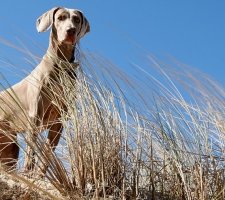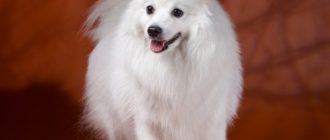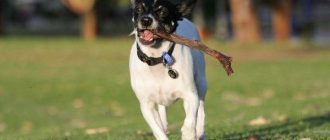Assessment of breed characteristics
Contents
| Adaptability Definition of how easy a dog is. can adapt to changes in life. |  |
| Shedding Level Level and frequency of hair loss in animal. |  |
| Level of tenderness Level and amount of tenderness and affection that the dog gives back in return for attention to itself. |  |
| Need for Exercise Daily Activity Level dogs. |  |
| Social need Required number of dog contacts with other animals as well as people. |  |
| Housing ratio Factor that determines the level of noise and other inconvenience that the dog can deliver to the owners in the ratio apartment size to dog size. |  |
| Grooming Number of bathing, combing, as well as necessary number of professional grooming sessions required the dog. |  |
| Friendliness in an unfamiliar environment society with strangers or in an unfamiliar environment. |  |
| The tendency to bark The tendency to bark and its frequency and volume. |  |
| Health Issues Potential Health Status dogs. |  |
| Territorial tendency of the dog to protect his house, yard or even a car owner. |  |
| Cat friendliness A trend towards cat tolerance and reduced manifestation of hunting instincts. |  |
| Intelligence Dog’s ability to think and solve emerging difficulties (not to be confused with learning!). |  |
| Education and training Level of difficulty in training a dog perform certain actions. |  |
| Friendliness for children Factor determining how much the dog friendly to children, whether she likes to play with them and endure some children’s pranks. |  |
| Game activity The concept is determined by its very name, and, usually found in almost all dogs. |  |
| Observing Dog’s ability to detect presence a stranger in his territory. |  |
| Friendliness for other dogs Dog’s tendency to find common language with other relatives. |  |
Brief description of the breed
Weimaraners (aka Weimar Pointing Dogs) – hunting guns dogs come from Germany. In their hunting group they belong to Continental Pointing Dog Equally Well Developed upper and lower flair, which makes them valuable and prey by hunters. Top flair allows weimaraners to search for game by smell (almost regardless of the strength of the wind), the bottom – in the wake. Are looking for wounded Weimaraner prey and the bloody trail. Hunters Weimar cops are valued for their reliability, excellent sense of smell and devotion. Most often these dogs are used for wild birds (snipe, corncrake, duck, partridge, quail) and animals (hare, fox). But these dogs have earned respect in other fields – they can become excellent search engines as well as companions. Faithful loving in return for a kind and sincere attitude, with sustainable psyche, weimaraners are almost universal dogs, not requiring special care. In our country there are many people and not suspects such a breed, although in Weimaraner hunting circles long respected and loved. We can say that weimar cops are great dogs for active families as they kind, lively and funny. Weimaraners – Large enough dogs (their growth is 60-70 cm, weight – 25-40 kg) with well developed bones and muscles. The hair of dogs of this breed can be of two varieties – long or short. Long wool weimaraner to the touch soft, with a slightly pronounced undercoat, tows are present on the ears, chest, abdomen and tail of dogs. Shorthaired weimaraners have thick enough hair, shiny, tight to the body, without a noticeable undercoat. But there is also a mixed type of coat – thick hair of medium length with moderate tow. The color of the weimaraner wool is always gray – from silvery pale to dark. On the head and ears of dogs of this breed the coat is slightly paler than on the whole body (on the back a strip of dark gray shade is present, small ones are acceptable white marks in the area of the paws and chest). Weimar Pointing Head dry, with a pronounced groove along a non-convex forehead, zygomatic arches clearly visible, the muzzle is long. The eyes are round, light or dark amber shade (in puppies of a blue shade). The back of the nose slightly convex, the lobe is large, brown-gray. The ears always hanging, wide, set high, looking forward. The Weimaraner neck is dry and muscular, broad at the base, turns into a proudly towering withers. The chest is wide enough. The back of the Weimaraner is distinguished by extension, in the area of the croup noticeable tilt. The tail is resting downward. Limbs Weimaraner bony, muscular, straight.
Weimaraner photo:








 Photo of Weimaraner dogs |
Photo of Weimaraner dogs |
Origin history
The breed was recognized in 1896 in Germany. It is known that dogs similar to modern weimaraners were common already in the XVII century and they were used as assistants in the hunt. But reliable information regarding the origin of these silver-gray dogs do not exist. According to one version, Weimar the cops were brought into Germany by the Duke Karl Augustus Saxe-Weimar-Eisenach from the Czech Republic. According to another version Weimaraners originally lived in Germany, and their ancestors were marriages – hunting cops. Weimar Pointing Dogs attracted to the prey of a large beast. Known History of Hunting Facts weimaraner on a bear, roe deer, wild boars.
Weimaraner Character
Weimaraners are dogs with a wonderful character. These animals are good-natured, but sometimes they can show character, for example, doing anything contrary to the owner. They get attached very quickly to his master and other family members. Get along well Weimaraners and with children. They treat pets well, if the owner has taught the dog correct behavior since childhood. Those dogs that from an early age make outings with purpose of hunting, have a special instinct and distrust of outsiders to people. They are always very attached to the owner, sensitive and affectionate, with great pleasure spend time next to the owner. Weimaraners are also very active, so the best place to live for them, these are suburban areas where you can run around and to frolic. Do not get a dog for the person who does not be able to spend enough time with her. Weimaraners yearn for the master, poorly endure separation from him. If this dog will spend too much time at home, it is possible torn things, bitten furniture and household items. The best purpose of the Weimaraners is hunting, because with for this purpose the breed was bred. Weimar Pointing Dogs are different a good level of intelligence, they are smart, smart. By the way, these animals do not differ in the increased level of aggression. They rarely raise barking is not the case. In short, weimaraners can be wonderful human friends and devoted hunters bringing great pleasure to its owner.
Maintenance and care
Weimaraners require long walks 2 or 3 times a day. Moreover dog walks should be not only long, but also interesting. Walking ain’t the best way to spend time with Weimaraner. Great if the owner will have the opportunity to train dog disciplines like frisbee or agility. Long sitting in the camps of the apartment does not suit Weimar gundogs, because the passion for will is in their blood. By the way, these dogs poorly tolerate separate accommodation with the owner, so it’s better not to Settle Weimaraner in enclosures and booths without access to housing. A dog living in the yard and rarely communicating with the owner may become lethargic and naughty. Weimaraners are aggressive extremely rare, therefore, as guards of housing and their lives usually do not start. Although, if necessary, weimaraners can stand up for yourself and for your adored owner. Weimar cops are completely unpretentious. Their fur only requires combing out every week. Bathing the same Weimaraner produce 2-3 once a year, and after walking the owner should only wipe paws of the dog. Be sure to clean the ears of the Weimaraner (weekly), monitor the hygiene of the mouth (brush your teeth each day), cut the claws (twice a month). As a food you can choose natural food or ready-made dry food. But should not purchase economy-class feeds because they only bring harm. It’s not necessary to feed the animal with food from the table, since greasy, sweet, seasoned with spices and seasonings food is not will bring benefits.
Training and education
The puppy must go through the process from the first days of appearing in the house socialization. Do not hide it from all people and dogs. Animal should be accustomed to the sounds of the city, to the behavior of other pets in the house (if any). At a young age, weimaraner needs train wearing a collar by putting it on a baby puppy daily on some time. If the Weimaraner will participate in the hunt, then some skills can be recognized by him at an early age. Weimaraners respond well to training if the owner is from an early age. age accustoms them to good behavior. For successful development Weimaraner teams should not be overloaded and punished excessively. If the dog is acquired as a companion, then passed The general course of training can very well be made from an animal educated and obedient friend. The hunting dog must the moment 4-5 months to accompany the owner during the sorties on nature. The training of Weimaraner-hunters comes from childhood, so that the dog learns all the subtleties of hunting. In those cases when the owner of the Weimaraner does not plan to participate in the hunt with the dog, sufficient loads should be selected in terms of any dog sport.
Health and Disease
Weimaraners live for about 10-12 years. One of the main roles is timely vaccination and disease prevention. Master Weimaraner must always pay attention to disturbing bells – temperature changes, gastrointestinal tract disorders, changes gait, discharge from the eyes, nose. Do not self-medicate dogs should be, and the animal is best shown to the veterinarian periodically for the prevention and possible detection of some diseases. It is good to have a first-aid kit for a dog at home, so that in case the need to provide first aid when the bill goes for minutes. Them health is often quite good, but dogs of this breed have some problems that include: hip dysplasia joint, skin problems (allergy, demodicosis, dermatitis), spinal cord diseases (degenerative myelopathy), diseases eye (cataract, corneal atrophy, eversion of the eyelid, distichiasis).






